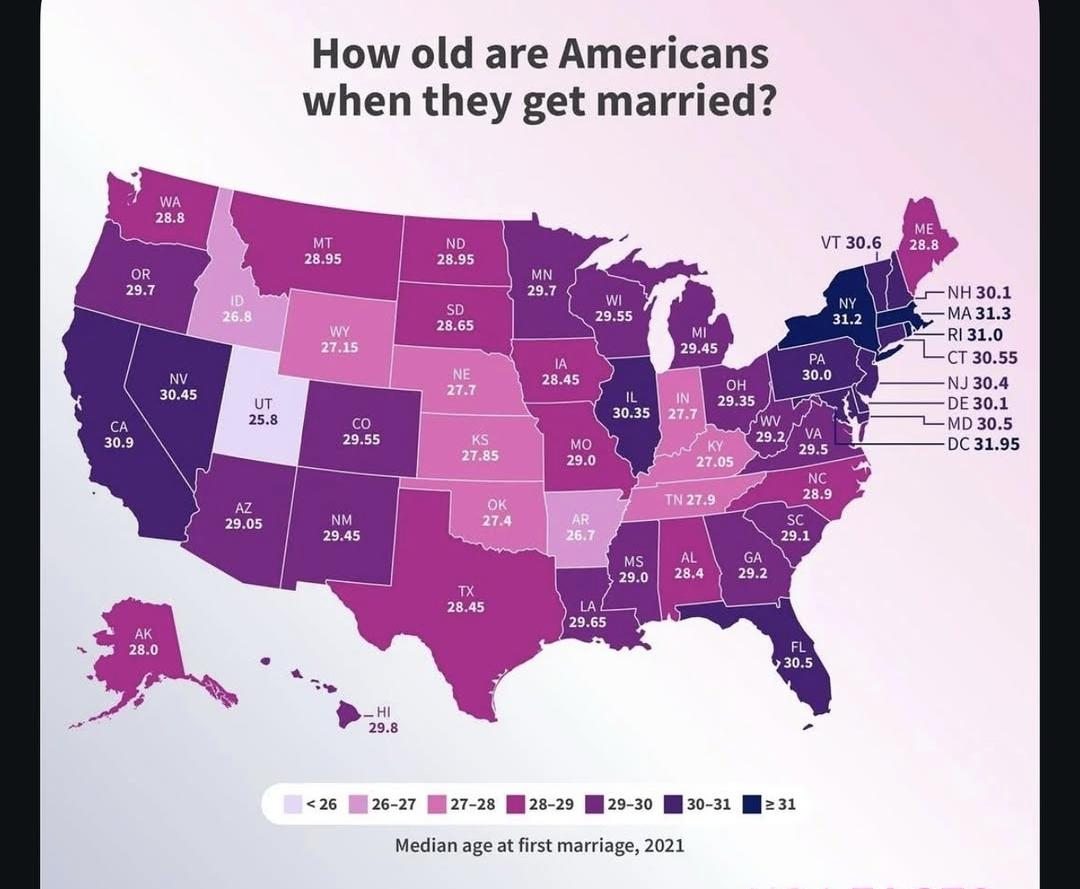Map of Age Americans are Getting Married


Alex Cartwright
Senior Cartographer & GIS Specialist
Alex Cartwright is a renowned cartographer and geographic information systems specialist with over 15 years of experience in spatial analysis and data...
Geographic Analysis
What This Map Shows
This map illustrates the average age at which Americans are getting married, providing a snapshot of societal trends and shifts in relationship dynamics across different states. By analyzing this visualization, we can glean insights into cultural, economic, and demographic factors that influence marriage age. In recent decades, there has been a noticeable trend of Americans marrying later in life, and this map captures the nuances of that trend across various regions.
Deep Dive into Age of Marriage in America
The average marriage age in the United States has steadily increased over the past few decades. In the 1970s, the average age for men was around 23 years old and for women, about 21. Fast forward to the 2020s, and those numbers have shifted dramatically to approximately 30 for men and 28 for women. This shift is indicative of broader societal changes that are affecting personal choices and priorities.
Interestingly, numerous factors contribute to this trend. One major influence is the increased emphasis on higher education. Today, more individuals are pursuing college degrees and advanced education, often delaying marriage until they have completed their studies and established their careers. As a result, young adults are focusing on personal and professional development before settling down.
Additionally, economic factors play a significant role. The financial burdens of student loans, housing costs, and economic instability can make early marriage less attractive. Young people often feel the need to achieve a certain level of financial security before taking the plunge into marriage. According to the U.S. Census Bureau, nearly 70% of adults believe that being financially stable is a prerequisite for marriage, which has led many to wait longer to tie the knot.
Moreover, cultural shifts have played a key role in changing attitudes toward marriage. In contemporary society, there is a greater acceptance of cohabitation and long-term relationships without marriage. This has led many couples to live together for years, sometimes indefinitely, before deciding to marry. As a result, the traditional timeline of courtship and marriage is evolving.
It's also important to consider the impact of technology and social media on relationships today. With dating apps and social networks, individuals have more opportunities to meet potential partners, which can lead to longer dating periods before marriage. People are taking their time to find the right match, resulting in a more selective approach to choosing a life partner.
Regional Analysis
When we look at the map, it becomes apparent that marriage ages vary significantly across the United States. For instance, in states like Massachusetts and New York, the average marriage age tends to be higher, often exceeding 30 years for men. This can be attributed to urbanization, educational opportunities, and economic conditions prevalent in these states. Urban areas typically offer more career opportunities, leading individuals to prioritize their professional lives before settling down.
Conversely, states such as Arkansas and Mississippi exhibit lower average marriage ages, often around 24 to 26 years. This difference can be linked to cultural factors, where traditional values around marriage and family still hold significant influence. In these regions, there may be a stronger emphasis on early marriage as part of societal norms.
Interestingly, the South generally shows a trend of younger marriage ages compared to the Northeast and West Coast. This regional disparity reflects not only cultural attitudes towards marriage but also economic conditions and educational attainment levels. For example, in areas with lower educational attainment, individuals may marry earlier as a norm within their community.
Significance and Impact
Understanding the trends in marriage age is not just about numbers; it reflects a broader societal evolution. The changing landscape of marriage can have profound implications for family structures, economic conditions, and social policies. For instance, as people marry later, there may be shifts in family planning, with more individuals opting for fewer children or delaying parenthood.
Moreover, these trends can impact the economy. As young adults delay marriage, they often delay home buying, which can affect the housing market and related industries. It’s essential for policymakers, educators, and businesses to recognize these trends and adapt accordingly.
Looking ahead, projections suggest that the average marriage age will continue to rise. As more individuals prioritize personal development and career advancement, societal norms surrounding marriage are likely to shift even further. This ongoing evolution invites us to consider the future of relationships and family life in America, as the journey to marriage becomes increasingly diverse and individualized.
Visualization Details
- Published
- October 13, 2025
- Views
- 26
Comments
Loading comments...